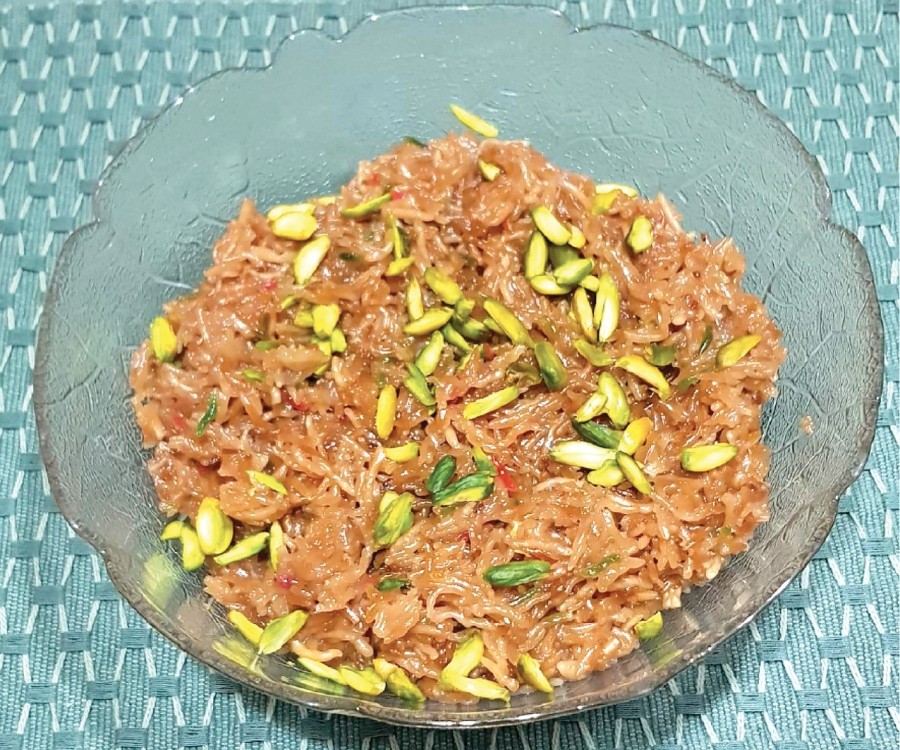
Ravinder Kaur Bali
Sydney, Australia
The spouse came home with a small jar of vermicelli the other day. Handmade vermicelli, mostly white, and flecked with colour: yellow, pink and green. Handmade vermicelli, just the way my grandmother used to make it: from dough made out of semolina and plain flour. She would make kilos and kilos of it, happily gifting it to friends and family. Vermicelli: the small sweet curls of dough that my cataract-blind grandmother made with her lined and gnarled hands; and which my mother cooked, with sugar or jaggery, ghee, and lots of nuts.
Looking at the jar in my hands took me back more than four decades. Beji, my grandmother, would make vermicelli, or 'seviyan' throughout autumn and winter, when the sun shone bright and strong. Yes, we had clear blue skies and bright sunlight in Kohima, throughout late autumn going into winter, because that was the only time the sun would shine. Starting in spring, and throughout the summers, the sun mostly got kidnapped by the monsoons that kept it hidden for days and days. Even in winter, we had the sun for just a few hours, for it then went over the hill and brightened the other side of the town, but while it was on our side of the hill, it was bright and warm, the way Beji liked, for drying her ‘seviyan’.
On many an evening, in a pre-television Kohima, I would sit with my grandmother, and make vermicelli with her as she deftly twisted the dough between her finger and thumb, giving it a soft curly shape. As she twisted the dough, she moved the woven bamboo kitchen tray so that the curls did not all fall in the same spot and clump together. But much as I tried, I could never twist like her, going from the left hand to the right: I could only hold the ball of dough in my right hand, and twist it with my left thumb and forefinger. By the time we would be ready for bed, the tray would be filled with a tangle of curls. It would then be covered with muslin and left overnight on the dining table. In the morning, the tray would be put out in the sun to dry. Once dry, my mother would roast the vermicelli, cool it, and add it to the growing vermicelli stash. It would be cooked whenever we wanted something sweet, and for breakfast most Saturdays, to go with boiled and spiced ‘black chana’, and fried goat liver.
Friends of mine who dropped in and often saw Beji making the vermicelli were always amazed by her dexterity. I particularly remember one classmate, let’s call her B, who lived nearby, and was a frequent visitor. The school I went to, Little Flower School, crowned a hill overlooking Kohima town, and we lived in a house near the bottom of that hill, a stone’s throw from the police station that initially stood on NH39. In fact, a police post was located right outside our gate, a huge rocky outcrop advertising the whereabouts of the local roadside constabulary. I recall that soon after we moved into the house, in early 1975, our landlord, an Angami gentleman, requested the police station to move the post, as it was on his land. Thereafter, the fence was extended to bring the rocky outcrop into the front yard, and my father promptly sought the landlord’s permission to wall in the rock, converting it into a little tank for fish, and a weekend picnic spot for us. The low enclosing wall of this fish-pond, overhung by a white magnolia tree was where I would sit and chatter with my friends when they dropped in.
Classmate B lived further out from our place, beyond the police station, and almost halfway to the CRPF Camp that sprawled on a ridge off NH39 on the way to Jakhama. B had a path to the school from her place, but it was a very steep climb that she did not always like taking alone, so she would often take the main road to our place and we would walk together to school and back. Many times, on our return from school, I would ask her to come in and have a cup of tea before tackling the next 2-odd kilometres she still had to cover. And of course, my grandmother would welcome her, as she would all my friends, undeterred by her failing vision or by the Punjabi-Nagamese-English barrier.
It was during one such visit, that I left B admiring my grandmother’s handiwork, and went off to make tea. When I returned to the veranda, it was to find that B and grandmother mine had gone into business together, and were making quite a roaring success of it, going by the two competing piles of vermicelli being rapidly churned out. With me the interpreter gone, Beji minus English-Nagamese, and B minus Punjabi-Hindi had managed to communicate. Somehow, Beji had been able to convey to A that she should go wash and dry her hands thoroughly before rubbing butter on them. Beji had then handed her a little ball of dough, showing her how to twist and pinch off the curls of dough. And that was how I found them, smiling as they sat across each other, and wordlessly twisting ‘seviyan’ onto a bamboo kitchen tray on a sunny autumn afternoon in Kohima. Sometime in the mid-70s.
When B came home the next day, my mother had obediently (at Beji's behest), prepared a large bowl of vermicelli. Enough for us to eat and for B to take some home. And a packet of the dry uncooked ones as well. An apt celebration of an instance where barriers of age, language and culture disappeared into a bowl of vermicelli. Wordlessly too. Perhaps a fitting finale to something that my father had initiated seven years earlier. But that, then, is another story, for another day.
I miss my grandmother, gone a quarter century already. I hope you are happy and hearty, B, my friend.
P. S. I was able to contact B through the kindness of a mutual friend, and we had a long and happy conversation on the phone. That was ten years ago.
Inspired by Jeanne Ray of the ‘Eat Cake’ fame, here is the recipe, for a bowl of sweet vermicelli, to share and make memories with.
2 cups of vermicelli (available as thin or thick, pre-roasted; thick preferred)
3.5 cups of water
1 tbsp ghee
1.5 cups or less of sugar/jaggery/molasses
2 cardamoms, seeds only, crushed
Nuts or dry fruit as per choice.
Method:
Place a thick- bottomed wok on fire, add ghee, and start roasting vermicelli on medium heat. Take care not to brown the vermicelli, it should have a light brown- beige colour when done, in about 15-20 minutes.
If your vermicelli come pre-roasted, just add to ghee, stir 2-3 minutes on low heat and go to the next step.
Add all the water, bring to a rolling boil, then turn the heat down so that it is simmering. It takes a while to reduce the water, so keep stirring every now and then. In about 20- 25 minutes, the water will have reduced considerably. Add sugar, cardamom, and any nuts or dry fruit you fancy. Stir to mix everything, reduce heat to lowest, cover and simmer for 5 minutes. Turn the heat off, and let it sit covered for at least 15 minutes. Uncover, fluff with a fork, and serve. Makes enough for a sweet toothed family of 5-6 people. Enjoy!






